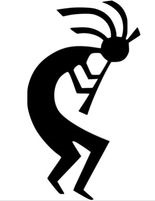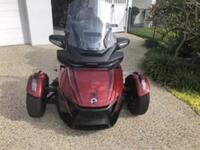|
-
 Wiring aftermarket horns Wiring aftermarket horns
Well, I recently spent two days troubleshooting and fixing a problem with my wife's bike's horn, which never sounded right, then worked only intermittently, then stopped altogether.
We bought her bike used and a previous owner had replaced the OEM horn with a Stebel Nautilus, which is much louder. The reason aftermarket horns can generate more decibels is because they have a high speed electric motor driving an air pump. This motor draws anywhere from 14 amps to 17 amps, depending on the make and model. The OEM horn, on the other hand, draws only 5 amps or less.
Now, the OEM horn is powered directly from the handlebar switch, using relatively small wires to do so. Those wires are inadequate to carry the much higher amperage of the aftermarket horns. So, when buying an aftermarket horn, it is essential to add a 30 amp relay into the circuitry. Horns sold specifically for Motorcycles typically have the relay and associated wiring included, but some do not.
Whoever installed the Stebel did it correctly, using a relay, which activates when the horn button is pushed, thus closing another set of contacts carrying battery power directly to the horn on larger (14awg) wires. Sometimes this power comes off an aftermarket fuse block powered by the battery, but that's not relevant; the point is that the power to the horn is being provided by larger wires, not the horn button wires. In this case, the previous owner had used an Eastern Beaver PC-8 to handle the power needs of accessories such as the aftermarket horn. All well and good.
Using a voltage detector probe, I determined the wire providing unswitched power to the PC-8 from the battery probably was the culprit. First, I disconnected the battery end and determined the wire was almost broken at the ring terminal, probably from when I replaced the battery (it's tight in there and the battery connections take a lot of abuse). So I replaced the ring terminal, soldered it in, and wrapped the whole thing with many layers of electrical tape to give it more strength.
The power at the PC-8 was still intermittent so I traced back to where a splice had been put in the line and replaced it. That didn't fix it. So then I examined the inline fuse close to the battery and determined its contact points to be suspicious so I replaced that with a new fuse holder. In so doing I had to splice back in the original cable but when I tried stripping the insulating jacket discovered the copper strands were corroded and breaking off, so I replaced that wire also.
That fixed it finally and now the Stebel puts out the loud two-tone honk it's famous for. See below for pics of the horn wiring and the bad wire.
NOW, here's the interesting thing I discovered as a result of this experience. Upon checking MY bike's aftermarket WOLO horn, I found it is wired directly to the horn button, NOT through a relay! I'm amazed I haven't had problems with it before now, but will be rewiring it with a relay before the next trip.
I bought my 2014 RTL new and shortly thereafter went to the Red Rock Rally in St. George, where I discovered farkling for the first time. I promptly dropped $900 having LEDs installed AND the WOLO horn installed by the same vendor. I knew nothing about modifying the Spyder back then, but have since learned a lot from this forum and now pretty much do all my own maintenance and mods.
20210703_115207~2.jpg
1625336529167_20210703_115302~2.jpg
2014 RTL Platinum

-
Very Active Member


Very thorough explanation and a tidy looking installation. It should be a benefit to others considering horn changes or trouble shooting horn problems. Well done.
-
Very Active Member


Thank you for the post and explanation.
Good teaching narrative.
David C
2016 F3T
DIY Garage Door Opener & GPS Mount
Battery tender cable
Rear IPS Pack Rack

-
Very Active Member


Wow……thanks for taking the time to document this, Pete. I learnt a huge amount from this post. 
I have an intelligent Neutrino fuse box which is wired direct to the battery and has intelligent fuses and relays incorporated, making installation soooooo much easier (as long as you use the right gauge wire to connect the accessories like horn, heated gear etc.). It also has a dedicated connection in the box to connect your battery tender……works a treat
Pete
Harrington, Australia
2021 RT Limited
Setup for Tall & Big.... 200cm/6'7", 140kg/300lbs, 37"inleg.
HeliBars Handlebars
Brake rubber removed to lower pedal for easier long leg/Size 15 EEEEW boot access.
Ikon (Aussie) shocks all round.
Russell Daylong seat 2 taller than stock (in Sunbrella for Aussie heat & water resistance)
Goodyear Duragrip 165/60 fronts (18psi) - provides extra 1/2 ground clearance.
Kenda Kanine rear.
2021 RT Limited , Brake pedal rubber removed for ease of accessing pedal with size 15 boots. Red
-

 Originally Posted by Peteoz

Wow……thanks for taking the time to document this, Pete. I learnt a huge amount from this post. 
I have an intelligent Neutrino fuse box which is wired direct to the battery and has intelligent fuses and relays incorporated, making installation soooooo much easier (as long as you use the right gauge wire to connect the accessories like horn, heated gear etc.). It also has a dedicated connection in the box to connect your battery tender……works a treat 
Pete
https://www.neutrinoblackbox.com/
Looks spiffy!
2014 RTL Platinum

-
Active Member


UtahPete - Having the horn wired so that you press the horn button to activate is a good idea. What you can do is use the horn circuit to activate the relay that provides power to the new upgraded horn - this is a low power circuit. You would take the wire at the OEM horn that is from the horn button, use it to trigger the new horn relay. Use 16 gauge wire to run power to the relay and then to the horn - 14 gauge is overkill for a short run, but your choice. You can use the ground that was used for the OEM horn(s) to ground the relay. Install the new relay at the old OEM horn position so that you can use the power and ground wires. You will have to provide a fused circuit for the new upgraded horn.
Cheers
"When Writing the Story of Your Life, Dont Let Anyone Else Hold the Pen"
"Too many of us are not living our dreams because we are living our fears. Les Brown
2014 Can-Am Spyder RT LE
1985 Honda GL1200 Goldwing Limited Edition
Ernest
 Posting Permissions
Posting Permissions
- You may not post new threads
- You may not post replies
- You may not post attachments
- You may not edit your posts
-
Forum Rules
|





 Reply With Quote
Reply With Quote




